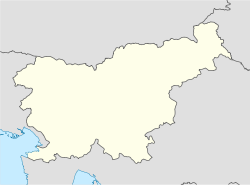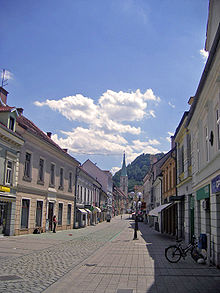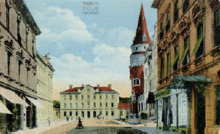- Celje
-
Celje — City and Municipality — Celje from the Celje Castle in 2004 
Flag
Coat of armsNickname(s): Knežje mesto (The Prince Town) Location of the Municipality of Celje in Slovenia Location of the city of Celje in Slovenia Coordinates: 46°14′09″N 15°16′03″E / 46.23583°N 15.2675°E Country  Slovenia
SloveniaMunicipality Celje Municipal Rights AD 45 (as municipium Claudia Celeia) Districts & local communities List- Districts
- Center
- Dečkovo naselje
- Dolgo polje
- Gaberje
- Hudinja
- Karel Destovnik Kajuh
- Lava
- Nova vas
- Savinja
- Slavko Šlander
- Local communities
- Aljažev hrib
- Ljubečna
- Medlog
- Ostrožno
- Pod gradom
- Škofja vas
- Šmartno v Rožni dolini
- Teharje
- Trnovlje
Government - Mayor Bojan Šrot (SLS) Area - Total 94.9 km2 (36.6 sq mi) Elevation 241 m (791 ft) Population (2010) - Total 37,520 Time zone CET (UTC+1) - Summer (DST) CEST (UTC+2) Postal code 3000 Area code(s) 03 Twin Cities - Grevenbroich  Germany
Germany- Singen  Germany
Germany- Slavonski Brod  Croatia
CroatiaWebsite celje.si Source: Statistical Office of the Republic of Slovenia, census of 2002. Celje (
 listen (help·info)) is a typical Central European town and the third largest town in Slovenia. It is a regional center of Lower Styria and the administrative seat of the Urban Municipality of Celje (Slovene: Mestna občina Celje). The town of Celje is located under Upper Celje Castle (407 m) at the confluence of the Savinja, Ložnica, and Voglajna rivers in the lower Savinja Valley. It lies 241 m above mean sea level (MSL).[1]
listen (help·info)) is a typical Central European town and the third largest town in Slovenia. It is a regional center of Lower Styria and the administrative seat of the Urban Municipality of Celje (Slovene: Mestna občina Celje). The town of Celje is located under Upper Celje Castle (407 m) at the confluence of the Savinja, Ložnica, and Voglajna rivers in the lower Savinja Valley. It lies 241 m above mean sea level (MSL).[1]The Celje region is frequently shaken by minor earthquakes.
In the local colloquial Slovene dialect, Celje is called Cjele or Cele, giving it a special modulation, spoken mainly by its citizens.
Contents
History
The first settlement in the area of Celje appeared during the Hallstatt era. The settlement was known in the Celtic times and to Ancient Greek historians as Kelea; findings suggest that Celts coined Noric money in the region.
Once the area was incorporated in the Roman Empire in 15 BC, it was known as Civitas Celeia. It received municipal rights in AD 45 under the name municipium Claudia Celeia during the reign of the Roman Emperor Claudius (41-54). Records suggest that the town was rich and densely populated, secured with the walls and towers, containing multi-storied marble palaces, wide squares, and streets. It was called Troia secunda, the second; or small Troy. A Roman road through Celeia led from Aquileia (Sln. Oglej) to Pannonia. Celeia soon became a flourishing Roman colonies, and many great buildings were constructed, such as the temple of Mars, which was known across the Empire. Celeia was incorporated into Aquileia ca. 320 under the Roman Emperor Constantine I (272-337).
The city was razed by Slavic tribes during the Migration period of the 5th and 6th centuries, but was rebuilt in the Early Middle Ages. The first mention of Celje in the Middle Ages was under the name of Cylie in Wolfhold von Admont's Chronicle, which was written between 1122 and 1137.
The town was the seat of the Counts of Celje from 1341 to 1456 It acquired market-town status in the first half of the 14th century and town privileges from Count Frederick II on 11 April 1451.
After the Counts of Celje died out in 1456, the region was inherited by the Habsburgs of Austria and administered by the Duchy of Styria. The city walls and defensive moat were built in 1473. The town defended itself against Turks and in 1515 during great Slovene peasant revolt against peasants, who had taken Old Castle.
Many local nobles converted to Protestantism during the Protestant Reformation, but the region was converted back to Roman Catholicism during the Counter-Reformation. Celje became part of the Habsburgs' Austrian Empire during the Napoleonic Wars. In 1867, after the defeat of Austria in the Austro-Prussian War, the town became part of Austria-Hungary.
The first service on the Vienna-Trieste railway line came through Celje on 27 April 1846. In 1895, Celje secondary school, established in 1808, began to teach in Slovene.
At the end of the 19th century and in the early 20th century, Celje was a center of German nationalism which had repercussions for Slovenes. The 1910 census showed that 66,8% of the population was German.[2] A symbol of this was the German Cultural Center(German: Deutsches Haus), built in 1906 and opened on 15 May 1907, today it is Celje Hall (Slovene: Celjski dom). The centuries-old German name of the town, Cilli, sounded no longer German enough to some German residents, the form Celle being preferred by many. The 1911 Encyclopædia Britannica listed the town under the German name Cilli.
Population growth was steady during this period. In 1900, Celje had 6,743 inhabitants and by 1924 this had grown to 7,750. The National Hall (Narodni dom), which hosts the Mayors Office and Town Council today, was built in 1896. The first telephone line was installed in 1902 and the city received electric power in 1913.
Slovene and German ethnic nationalism increased during the 19th and early 20th centuries. With the collapse of Austria-Hungary in 1918 as a result of World War I, Celje became part of the Kingdom of Serbs, Croats and Slovenes (later known as Yugoslavia). During this period, the town experienced a rapid industrialization and a substantial growth in population.
Celje was occupied by Nazi Germany in April 1941. The Gestapo arrived in Celje on 16 April 1941 and were followed three days later by SS leader Heinrich Himmler, who inspected Stari pisker. During the war the city suffered from allied bombing, aimed at important communication lines and military installations. The National Hall was severely damaged.
The toll of the war on the city was heavy. The city (including nearby towns) had a pre-war population of 20,000 and lost 575 people during the war, mostly between the ages of 20 and 30. More than 1,500 people were deported to Serbia or into the German interior of the Third Reich. Around 300 people were interned and around 1,000 people imprisoned in Celje's prisons. An unknown number of citizens were 'forcibly' conscripted into the German army. Around 600 "stolen children" were taken to Nazi Germany for germanization. A monument in Celje called Vojna in mir (War and Peace) by the sculptor Jakob Savinšek, commemorates the World War II era.
After the end of the war, the remaining German-speaking portion of the populace was expelled. The new communist government took advantage of existing anti-tank trenches, dug around Celje by the retreating German army, by using them as mass graves. They were filled with Croatian, Serbian, and Slovenian militia members who had collaborated with the Germans, as well as civilians who had opposed either the national liberation movement or the communist revolution during the war, civilians of German descent or simply individuals accused or suspected of anti-communism. The purpose was to physically eliminate any potential political opposition, on the pretext of collaboration with the enemy. The Yugoslav National Army executed more than 80,000 - mostly Croat, German and Slovenian - prisoners in the Celje area, without any judicial process. The bodies were buried in hidden mass graves in Celje; the exact number is still not known. At the concentration camp at Teharje, some 5,000 Slovenians, hundreds of them minors, were murdered within two months after the end of the war, again without trial. Furthermore, refugee trains carrying German civilians from the "Rann triangle" area were halted near Celje on August 5, 1945 and their passengers sent to a concentration camp at Teharje. After the camp was closed in 1950, the local authorities established a huge industrial dump over the graveyard there, concealing the evidence of killings under a mound of toxic waste. In the middle 70s, 30 years after crimes, the local authorities build preschools, schools, blocks, halls and other objects on mass graves. In 1991, when it became possible again to discuss the facts pertaining to the massacre, the Slovenian government decided to build a memorial to the victims of Teharje.
Celje became part of independent Slovenia following the Ten-Day War in 1991. On April 7, 2006, Celje became the seat of a new Diocese of Celje, created by Pope Benedict XVI within the Archdiocese of Maribor. The town's tourist sights include a Grayfriars' monastery founded in 1241 and a palace from the 16th century.
Symbols
The coat of arms of Celje are based on the coat of arms of the Counts of Celje.
The coat-of-arms of Celje was selected for the national arms immediately after World War I in 1918, when Slovenia together with Croatia and Serbia formed the original Kingdom of Serbs, Croats and Slovenes (later Yugoslavia). A similar coat of arms was integrated into the Slovenian national arms in 1991.
Subdivisions
Settlements
39 settlements are included in the urban municipality:
Districts and local communities
The town of Celje is divided into 10 districts (mestne četrti) and the municipality 9 local communities (krajevne skupnosti):
Districts
Local communities
Demographics
Year Population[3] 1439 1,000 1798 1,400 1820 1,635 1834 1,511 1840 1,793 1900 6,743 Year Population 1924 7,750 1940 20,000 1995 40,710 2002 48,081 2007 45,826 2010 50,039 
In 1991 in the town lived:
- Slovenians: 33.434 (82,1%)
- Serbs: 1864 (4,6%)
- Croats: 1687 (4,1%)
- Muslims by nationality: 466 (1,1%)
- Yugoslavs: 405 (1%)
- Albanians: 189
- Macedonians: 140
- Montenegrins: 93
- Hungarians: 41
- Others: 82
- Unknown: 1972 (4,8%)
- Undeclarated: 249
- Regionally declarated: 88
Celje has 47,660 citizens as of 2002:
- Male: 22,744;
- Female: 24,816;
- Households: 18,410;
- Mean number of household members: 2.6;
- Apartments: 19,578;
- Buildings with apartments: 8,090.
The Celje annual municipal festival is held on April 11.
Education
Celje does not have its own university, although some college-level education has been established in the city. The Faculty of Logistics, formally part of the University of Maribor, was established in Celje in 2005. In 2006, Tehnopolis Celje was established, a technological center with an international university. The project will be completed in 2013.
Law and government
Mayor
The current mayor of Celje is Bojan Šrot, elected for the fourth time in 2010.
Courts
In Celje there are three courts of general jurisdiction:
- Celje Higher Court;
- Celje District Court;
- Celje Local Court.
In addition to that there are also Celje Labour Court for resolving labour law disputes and an external department of Administrative Court for resolving disputes arising from administrative procedures.
Communications
Postal number: SI-3000 (from 1991). (Old one: 63000 (between 1945–1991)).
Twin cities and friendship towns
Twin cities[4] Grevenbroich  Germany
Germany(since 1986) Singen  Germany
Germany(since 1990) Slavonski Brod [4][5]  Croatia
Croatia(since 2010) Friendship towns Budva  Montenegro
MontenegroCherepovets  Russia
RussiaĆuprija  Serbia
SerbiaGraz  Austria
AustriaSpittal an der Drau  Austria
AustriaNotable residents
- Hermann II of Celje (1365–1435), Count of Celje, Ortenburg and Seger
- Anna of Celje (1381–1416), second wife of Jogaila - king of Poland and Grand Duke of Lithuania
- Barbara of Celje (1390/1395-1451), second wife of Sigismund, Holy Roman Emperor
- Ulrich II of Celje (1406–1456), Count of Celje
- Thomas Berlower (Thomas of Cilli) (1421–1496), Bishop of Konstanz from 1491–1496
- Ambrosy of Belaya Crintsa (Ambrosy of Belaya Crintsa) (1791–1863), Old Believers Bishop
- Johann Krainz(1847–1907), Austrian writer ("Hans von der Sann")
- Vatroslav Oblak (1864–1896), linguist
- Josip Tominšek (1872–1954), linguist and alpinist
- Cvetko Golar (1879–1965), poet and author
- Margarete Weinhandl(1880–1975), Austrian writer
- Vladimir Levstik (1886–1957), author and translator
- August Friedrich Seebacher (1887–1940), painter and graphic artist
- Alma Karlin (1889–1950), traveller, author, poet, and collector
- Anica Černej (1900–1944), poet, author, and schoolmistress
- Thea Gammelin (1906–1988), painter
- Josef Kaiser (1910–1991), architect
- Darinka Pavletič-Lorenčak (born 1924), painter and graphic artist, poet, honorary citizen of Celje
- Andrej Hieng (born 1925), author
- Lojze Rozman (1930–1997), actor
- Milan Pogačnik (born 1946), politician
- Janez Drozg (1933–2005), film director
- Emerik Bernard (born 1937), painter
- Janez K. Lapajne (born 1937), geophysicist and seismologist
- Janez Drnovšek (1950–2008), politician, statesman, and third president of Slovenia
- Bina Štampe Žmavc (born 1951), poet and author
- Brina Zupančič (born 1953), pianist and composer
- Jelko Kacin (born 1955), politician
- Oto Pestner (born 1956), musician and singer
- Romana Jordan Cizelj (born 1966), physicist and politician
- Janez Lapajne (born 1967), film director
- Gregor Cankar (born 1975), athlete
- Jolanda Čeplak (born 1976), athlete
- Urška Žolnir (born 1981), judoist
- Beno Udrih (born 1982), basketball player
- Lucija Polavder (born 1984), judoka
- Vita Mavrič, chanteuse and singer
- Janko Orožen, historian
- Andreja Rihter, minister of culture of Slovenia
- Draža Mihailović (1893–1946), Serbian resistance leader
- Bogumil Vošnjak (1882–1955), scholar, politician, diplomat
Gallery
-
Upper Celje Castle, viewed from the banks of Savinja River in Pečovnik toward the northeast.
Notes
- ^ Celje Municipality site
- ^ For more information on the 1910 Austro-Hungarian census, see Geographischer Atlas zur Vaterlandskunde an der österreichischen Mittelschulen. K. u. k. Hof-Kartographische Anstalt G. Freytag & Berndt, Vienna 1911.
- ^ Orožen, pp. 362-365
- ^ a b "Partnerska mesta" (in Slovene). http://moc.celje.si/uprava/cgi/MOC.cgi?page=doc&doc=partnerska_mesta. Retrieved 2009-01-17.
- ^ Sporazum o prijateljstvu i suradnji između Grada Slavonskog Broda i Mestne občine Celje
References
 This article incorporates text from a publication now in the public domain: Chisholm, Hugh, ed (1911). Encyclopædia Britannica (11th ed.). Cambridge University Press.
This article incorporates text from a publication now in the public domain: Chisholm, Hugh, ed (1911). Encyclopædia Britannica (11th ed.). Cambridge University Press.- Orožen, Janko (1971). Zgodovina Celja in okolice, 1. del (History of Celje and surroundings) (in Celjski zbornik ed.). Celje: Kulturna skupnost v Celju.
External links
- Celje at Geopedia
- Official website (Slovene)
- Celjecafe.com Unofficial website, Celje forums, news, events, photos and more(Slovene)
- Celje municipal flag
- Teharje monument photos (Slovene)
Celje Neighborhoods Center - Dečkovo naselje - Dolgo polje - Gaberje - Hudinja - Karel Destovnik Kajuh - Lava - Nova vas - Savinja - Slavko ŠlanderLandmarks Celje Castle - Spodnji Celjski grad - Celje Railway Station - Novo Celje Mansion - Celje Town Walls - Water Tower - Old County - Celje Ceiling - Kalvarija -Prothasi Mansion - Marian Column - Town Hall - Iron Mansion -Slovene People's Theatre - National Hall - Celje Hall - Celje Post Office -People's Savings Bank - Stari pisker Prison - Minorite Monastery - War and Peace (Monument) - Celje Hut - Grmada - Jošt's Mill - Celje AirportLocal communities Aljažev hrib - Ljubečna - Medlog - Ostrožno - Pod gradom - Škofja vas - Šmartno v Rožni dolini - Teharje - TrnovljeSettlements Brezova, Bukovžlak, Dobrova, Glinsko, Gorica pri Šmartnem, Jezerce pri Šmartnem, Košnica pri Celju, Lahovna, Leskovec, Lipovec pri Škofji vasi, Ljubečna, Lοče, Lokrovec, Lopata, Medlog, Osenca, Otemna, Pečovnik, Pepelno, Prekorje, Rožni Vrh, Runtole, Rupe, Slance, Slatina v Rožni dolini, Šentjungert, Škofja vas, Šmarjeta pri Celju, Šmartno v Rožni dolini, Šmiklavž pri Škofji vasi, Teharje, Tremerje, Trnovlje pri Celju, Vrhe, Začret, Zadobrova, Zvodno, ŽepinaCulture Notable people Emerik Bernard - Jolanda Čeplak - Anica Černej - Janez Drnovšek - Janez Drozg - Thea Gammelin - Cvetko Golar - Damjana Golavšek - Andrej Hieng - Stane Jagodič - Romana Jordan Cizelj -Jelko Kacin - Ivan Kovačič Efenka - Alma Karlin - Janez K. Lapajne - Janez Lapajne -Vladimir Levstik - Stanko Lorger - Matija Lubanus - Vita Mavrič - Drago Medved - Brane Mihajlovič Kosta - Miloš Mikeln - Peter Muhič - Vatroslav Oblak - Janko Orožen - Darinka Pavletič-Lorenčak -Oto Pestner - Rok Praznik - Tomaž Prelokar - Brikcij Preprost - Franc Purg - Andreja Rihter - Fran Roš - Lojze Rozman - August Friderik Seebacher - Bina Štampe Žmavc - Josip Tominšek - Beno Udrih - Urška ŽolnirCategories:- Celje
- Populated places in the Municipality of Celje
- Municipalities of Slovenia
Wikimedia Foundation. 2010.















